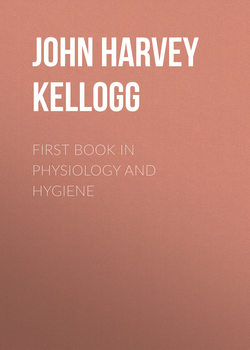Читать книгу First Book in Physiology and Hygiene - John Harvey Kellogg - Страница 6
CHAPTER IV
ОглавлениеOUR FOODS
1. We all know very well that if we do not eat we shall rapidly lose in weight, and become very weak and feeble. Did you ever think how much one eats in the course of a lifetime? Let us see if we can figure it up. How much do you suppose a boy eats in a day? Let us say two pounds. How much does he eat in a year? There are three hundred and sixty-five days in a year; 365 multiplied by 2 equals 730. So a boy eats a good many times his own weight in a year. How much would a person eat in fifty years?
2. Our bodies are composed of what we eat. If we eat bad food, our bodies will be made out of poor material, and will not be able to do their work well. So you see how important it is to learn something about our foods. We ought to know what things are good for us to eat, and what will do us harm.
3. Foods and Poisons.—Foods are those substances which nourish the body and keep it in good working order.
4. Our foods are obtained from both animals and plants. All food really comes from plants, however, since those animals which we sometimes use as food themselves live upon the vegetables which they eat. For example, the ox and the cow eat grass and furnish us beef and milk. Chickens eat corn and other grains, and supply us with eggs.
5. The principal animal foods are milk, cheese, eggs, and the different kinds of flesh—beef, mutton, pork, fish, fowl, and wild game.
We obtain a great many more kinds of food from plants than from animals. Most plant foods are included in three classes—fruits, grains, and vegetables.
6. Fruits are the fleshy parts of plants which contain the seeds. Our most common fruits are apples, pears, peaches, plums, cherries, and various kinds of nuts. Perhaps you know of some other kinds of fruits besides those mentioned. Your teacher will tell you that tomatoes, watermelons, and pumpkins are really fruits, though they are not generally so called.
7. The seeds of grass-like plants are known as grains, of which we have wheat, rye, barley, corn, and rice. There are a few seeds that grow in pods, such as pease and beans, which somewhat resemble grains.
8. We eat the leaves, stems, or roots of some plants, as cabbages, celery, turnips, and potatoes. Foods of this kind are called vegetables.
9. There are other things, which, if we eat or drink them, will make us sick or otherwise do us harm. These are called poisons. Only such food as is pure and free from poisons is good or safe for us to use.
10. Narcotics and Stimulants.—There are a number of substances known as narcotics and stimulants, which, from their effects upon the body, may be classed as poisons. Tobacco, opium, alcohol, and chloral are included in this class. Death has often been caused by taking small quantities of any of these poisonous drugs. We shall learn more of the effects of tobacco and alcohol in future lessons.
SUMMARY
1. Our bodies are made of what we eat.
2. Things which will help us to grow strong and well, if we eat them, are foods.
3. We get foods from plants and animals.
4. There are several kinds of animal foods, and three classes of plant foods—fruits, grains, and vegetables.
5. Things which make us sick when we eat them, are poisons.
